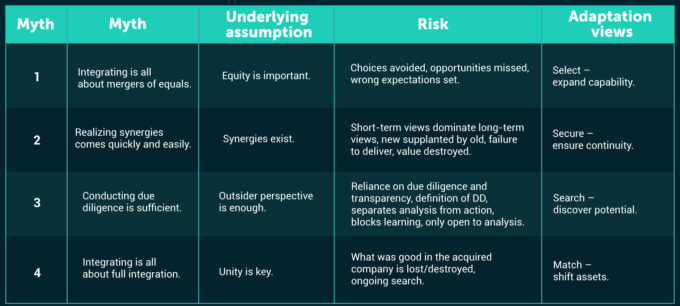Most mergers and acquisitions fail to deliver the expected results. Four myths are largely to blame: the belief that it must be a merger of equals, that synergies will come quickly and easily, that conducting due diligence will be enough, and that full integration is necessary.
In reality, both parties in the M&A process need to develop a shared understanding of their future (and not necessarily of their shared future). Based on our research findings, we suggest companies select, secure, search, and match.
Let’s look at each requirement in turn:
1 – Select
You should set priorities on capability building/strengthening (capability expansion). Amazon, for example, is adept at acquiring targeted capabilities, including Zappos for shoes, Audible for audiobooks, Whole Foods for high-end natural foods, Metro-Goldwyn-Mayer for its film library, and iRobot for its Roomba remote vacuum cleaners.
2 – Secure
It’s vital to ensure continuity over elusive synergies (continuity assurance). Successful acquirers of successful companies seek to keep existing customers and ensure the acquired company is not disrupted. For example, the luxury goods company Chanel maintains and strengthens the brand identities of many of its acquired companies, which continue to compete quasi-independently in their markets. Among them are the designer swimwear specialists Orlebar Brown, leather goods firms Colomer and Samata, and the shoemaker Ballin.
3 – Search
Due diligence before the deal does not cut it. You must take the time to explore and learn about the acquired company, its various units, and its respective capabilities to discover fresh opportunities (discovery of potential). We call this the “parking algo” – a way of analyzing an acquisition while it is temporarily parked. Such engagement prevents any hasty or rash decisions from being made. The “parking algo” can be created in a similar way to Siemens, which set up an umbrella structure in 2019 to create value from non-core businesses. Siemens Portfolio Companies target improving business performance and/or spinning off non-core businesses from the group. One success story is Flender, a manufacturer of mechanical and electrical drive technology, which was acquired by Siemens in 2005 for €1.2bn and sold 15 years later to The Carlyle Group for €2bn after its potential was spotted.
4 – Match
Even after you acquire, keep looking for potential acquirers (asset reallocation) that will make the asset’s most suitable match. Some units in acquired companies may not help grow the acquirer’s competitiveness and may be a much better fit for other companies. Thinking in alternative contexts/complementarities will help acquirers find more suitable owners for the benefit of all. For instance, IAC/Interactive Corp listed its travel-related units as Expedia on the public stock exchange in 2005. While TripAdvisor was part of Expedia, its growth and strength over time showed that its potential might be restricted. Therefore, the decision was taken to spin off TripAdvisor as a separate company to chart its own course.

Audio available








